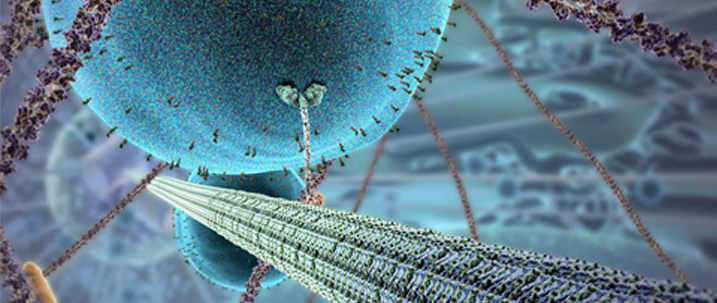The project aims at gathering physical, biological and statistical expertise to build a reliable inference procedure for the analysis of SPT experiments.
News
International Conference “Diffusion Fundamentals”
3-7 July 2017
Moscow, Russia
misis.ru/df7/
Transport of macromolecules, organelles and vesicles in living cells is a very complicated process that essentially determines and controls many biochemical reactions, growth and functioning of cells.
The passive thermal diffusion through the overcrowded cytoplasm is combined with the active transport by motor proteins attached to microtubules. This intricate mechanism results in anomalous diffusions that found abundant experimental evidences but no consensus on the physical mechanism and the appropriate mathematical model is achieved so far.
Single-particle tracking (SPT) experiments (video-tracking, optical tweezers, etc.) survey random trajectories of individual tracers inside living cells and can thus provide the missing information on the molecular transport in order to discriminate between different physical mechanisms (e.g., “caging” in the overcrowded cellular environment, visco-elastic properties of the cytoskeleton, hierarchical geometrical structure of the cytoplasm and/or nucleus, etc.) and to identify the appropriate theoretical model of anomalous diffusion (e.g., continuous-time random walks, generalized Langevin equation, diffusion on fractals, etc.).
In SPT, an ensemble average of the quantities of interest (e.g., diffusivity, viscosity, first passage times, etc.) is often unavailable or even undesired, as tracers move in spatially heterogeneous and time evolving media such as living cells. One faces therefore a challenging problem of inferring dynamical, structural and functional properties of living cells from a limited (small) number of individual random realizations of an unknown stochastic process.
H2 Analysis of Single Particle Trajectories — From Normal to Anomalous Diffusion
ActaPhysPol B 40,103 (2009) (ActaPhysPol B), number (40), page (103)
by Metzler, Tejedor, Jeon, He, Deng, Burov, Barkai
H3 First passage times of a jump diffusion process
AdvApplProb 35, 504-531 (2003)
by Kou, Wang
H2 News title Analysis of Single Particle Trajectories
07 JANUARY
ActaPhysPol B 40,103 (2009) (ActaPhysPol B), number (40), page (103)
by Metzler, Tejedor, Jeon, He, Deng, Burov, Barkai
Although this is the most basic and broadly used observable, its probability distribution even for the simplest case of free normal diffusion was not known until 2012 [Andreanov2012] (except for the elementary case of the lag time n=1, for which the TA MSD has a gamma distribution [Qian1991]). The knowledge of this distribution allows one to interpret single-particle measurements in a more accurate way. For instance, Fig. 3a shows four simulated trajectories of normal diffusion with diffusion coefficient D0=1 (a.u.). In experiment, this intrinsic diffusion coefficient would be unknown and has to be inferred from the trajectories. Since the mean TA MSD is equal to

Figure 3. (a) Four simulated trajectories of normal diffusion with T=100 steps and the intrinsic diffusion coefficient D0=1. Since the mean TA MSD is equal to 2D0t, one can use the TA MSD, computed from each individual trajectory, as a proxy of the diffusion coefficient: D = TA MSD/(2t). This is still a random variable which is expected to be close to the intrinsic value D0. For t=20, the inferred values for the shown trajectories are 0.5443, 0.3805, 0.7341 and 0.8736, illustrating a broad dispersion; (b) The probability distribution of the inferred diffusion coefficient D, obtained numerically from 1000 random trajectories (blue bins) and from the theory in [Grebenkov2011b,Andreanov2012] (red line). The black vertical line at D=D0=1 points on the mean value which is different from the most probable one (the position of the maximum).
Strikingly, only few rigorous results (mainly, of the asymptotic character) are known for probability distributions of other observables, especially for anomalous diffusions. In this project, we will consider the following theoretical problems:
|
Cell 1 |
Cell 2 |
Cell 3 |
| Option 1 |
1 |
2 |
3 |
| Option 2 |
4 |
5 |
6 |
| Option 3 |
7 |
8 |
9 |
List
- Strikingly, only few rigorous results (mainly, of the asymptotic character)
- Strikingly, only few rigorous results (mainly, of the asymptotic character)
- Strikingly, only few rigorous results (mainly, of the asymptotic character)
List 2
- Strikingly, only few rigorous results (mainly, of the asymptotic character)
- Strikingly, only few rigorous results (mainly, of the asymptotic character)
- Strikingly, only few rigorous results (mainly, of the asymptotic character)



